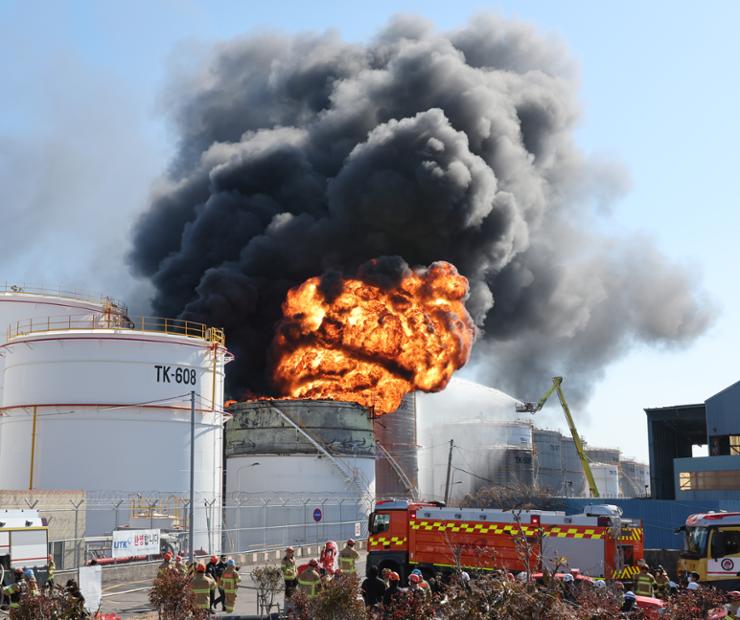Oil Storage Tank Blast Claims One Life in South Korea, Leaves Another Injured
An explosion at an oil storage facility resulted in one fatality and left another individual injured on the 11th of February, in Ulsan, South Korea. Reports from local media indicate that the victims were employees at the facility, engaged in inspecting the oil storage tank when the incident occurred.
The fire was fully extinguished within three hours, with major flames brought under control in approximately two hours. Fire authorities credited this swift response to the ‘large-volume spray system’ introduced in 2022, which is capable of spraying the equivalent of 26 large fire trucks’ worth of water.
According to fire officials on the 12th, a report was received at 11:15 a.m. the previous day regarding a fire at the oil storage tank of United Terminal Korea in Onsan-eup, Ulsan. The Onsan Industrial Complex is a key petroleum and chemical hub in South Korea, housing facilities such as the refinery S-OIL. United Terminal Korea specializes in unloading, receiving, storing, and shipping liquid cargo. The affected tank, which contained solvent, has a storage capacity of 2.5 million liters.
Emergency responders arrived at the scene at 11:26 a.m., just nine minutes after the fire was reported. A total of 185 personnel and 75 pieces of firefighting equipment, including three helicopters, a large-volume spray system, and seven firefighting vessels, were dispatched to combat the blaze. The major flames were brought under control by 1:33 p.m., and the fire was completely extinguished by 2:19 p.m., slightly over three hours after the initial report.
This rapid containment stands in contrast to the 17-hour firefighting operation required for a similar incident at the Goyang oil depot. That fire, which broke out at the Korea Oil Pipeline Corporation’s facility in Deogyang-gu, Goyang, on October 7, 2018, involved a tank holding 4.9 million liters of gasoline. Fire authorities deployed 243 firefighting units, including five helicopters, along with 790 personnel. Despite differences in tank size, the Ulsan incident saw only one-third of the equipment and one-fourth of the personnel used, leading to a significantly shorter firefighting duration.
The National Fire Agency emphasized the critical role of the large-volume spray system in containing the flames. Officials noted that once deployed, the system controlled the major flames within just 15 minutes. Initially introduced in January 2022, the system was specifically designed to address large-scale oil tank fires, such as the one in Goyang. Currently, two of these systems are stationed at the Ulsan Central 119 Rescue Headquarters Chemical Center, given the area’s concentration of major oil storage and processing facilities. An additional unit is set to be deployed at the Seosan 119 Chemical Rescue Center within the first half of this year.
The large-volume spray system in Ulsan is highly capable, with one unit discharging 45,000 liters of firefighting water per minute and another releasing 30,000 liters per minute, with a reach of up to 130 meters. This capacity is equivalent to 26 large fire trucks, each delivering over 2,800 liters per minute. Using submersible pumps, the system can draw water from natural sources such as lakes, rivers, or the sea, ensuring an uninterrupted firefighting supply.
The National Fire Agency stressed the importance of quickly suppressing large oil tank fires to prevent them from spreading to nearby tanks. They further announced plans to expand the deployment of these systems nationwide to enhance emergency response efficiency in the future.
The facility, operated by United Terminal Korea Limited in Ulsan, houses 64 tanks designated for liquid cargo storage. The company offers a range of services, including the loading, receiving, storing, and shipping of liquid materials, all managed through stringent inspection protocols.
Photo credit: Yonhap. All rights reserved.


